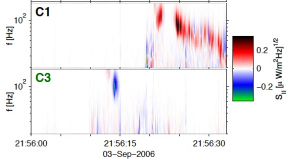Cluster observes jet braking and plasma heating
4 July 2011
High speed plasma flows, often referred to as jets, are extremely common across the Universe. Such jets are observed in Earth's magnetosphere, in solar flares, and near various objects powered by black holes. New insights into the processes that modify these streams of ionised particles have been provided by rare in situ measurements of plasma flows made by ESA's Cluster spacecraft.Most visible matter in the Universe exists as plasma, an extremely hot gas in which atoms have been stripped of electrons so that the particles become electrically charged (ionised) and magnetised. How this plasma is heated to create high-energy particles remains a fundamental question, since astrophysical plasmas are often so sparsely populated that collisions between particles are extremely rare.
| Cluster observations confirm that acceleration of energetic particles in the Earth's magnetotail is caused by magnetic reconnection followed by betatron acceleration. Credit: ESA/AOES Medialab (For larger versions of this video click here) |
One place where such processes can be studied by spacecraft is on Earth's night side, where the planet's magnetic field is drawn out into a long tail. In the centre of the tail is a region known as the plasma sheet, which contains plasma with ion temperatures of about 50 million degrees Celsius, making it one of the hottest places in the Universe. When magnetic reconnection occurs in the magnetotail, the plasma sheet is energised and jets are created.
Observations of high energy jets in the plasma sheet provide key insights into the processes that accelerate and heat the plasma. In particular, in situ measurements made by the four Cluster spacecraft have made it possible to pinpoint the mechanism responsible for the acceleration of energetic particles.
One important breakthrough has been made by a team from the Swedish Institute of Space Physics, Uppsala, and Mullard Space Science Laboratory, University College London, who analysed Cluster observations made on 3 September 2006.
 |
| Cluster observations of whistler-mode waves. Image courtesy of Y. Khotyaintsev, Swedish Institute of Space Physics, Uppsala |
The plasma jet was produced by magnetic reconnection, which occurred when the magnetic field lines from the south and north sides of the plasma sheet suddenly joined together. This focused the particles along the field lines, creating a jet. However, prior to the flow maximum, the team noticed a sharp increase in the strength of the magnetic field and an accompanying increase in electron energy to hundreds of kiloelectronvolts (keV).
The data indicate that the original, fairly "cold" jet was subsequently heated by a separate mechanism similar to friction. At first, the flow's interaction with other particles, together with the enhanced magnetic field, caused the front of the jet to slow down. This led to a pile up of the magnetic field in the plasma, rather like snow piling up in front of a moving snow plough.
Increasing magnetic field strength in this so-called 'flux pileup region' led to further heating of the plasma and acceleration of the electrons - a process known as betatron acceleration. The Cluster data revealed the presence of so-called 'whistler waves', providing the first confirmation that a persistent pile up process was driving the particle acceleration.
"In a more steady state situation, these waves would disperse rather quickly," said Arnaud Masson, Deputy Project Scientist for the Cluster mission. "However, the action of the pile up sustains them, providing a smoking gun of the ongoing pile up process itself."
"In line with previous studies, this new paper confirms that the betatron process takes place after magnetic reconnection, creating high-energy particles in the Earth's magnetotail," Masson added.
"What is remarkable here is how the high resolution time measurements made by the Cluster satellites have enabled the presence of electromagnetic waves and their role in the betatron process to be determined for the first time. The waves play a key role in this process by scattering the particles and effectively enhancing collisions between them, which are otherwise very rare."
The new measurements also provide new insights into plasma jets that occur far beyond our planet.
"In a general astrophysical context, our observations suggest that one can expect particle acceleration anywhere that plasma jets are interacting with the local environment and braking," said Yuri Khotyainsev of the Swedish Institute of Space Physics, lead author of the paper in Physical Review Letters.
"In addition to shocks, particle acceleration and heating will result from the pile up of the magnetic field at the jet fronts," he added. "Our data explain how jets can become more energised when they are far from the original site of magnetic reconnection."
Reference publication
Khotyaintsev, Yu. V., et al. (2011), Plasma Jet Braking: Energy Dissipation and Nonadiabatic Electrons, Physical Review Letters, vol. 106, 165001. doi:10.1103/PhysRevLett.106.165001
Related publications
Asano, Y., et al. (2010), Electron acceleration signatures in the magnetotail associated with substorms, J. Geophys. Res., 115, A05215. doi:10.1029/2009JA014587
Ashour-Abdalla, M., et al. (2011), Observations and simulations of non-local acceleration of electrons in magnetotail magnetic reconnection events, Nature Physics. doi:10.1038/nphys1903
Contact
Yuri Khotyaintsev
Swedish Institute of Space Physics
Uppsala University
Uppsala
Sweden
Email: yuri irfu.se
irfu.se
Arnaud Masson
Cluster Deputy Project Scientist
Directorate of Science and Robotic Exploration
ESA, The Netherlands
Phone: +31 71 565 5634
Email: Arnaud.Masson esa.int
esa.int
Matt Taylor
Cluster Project Scientist
Directorate of Science and Robotic Exploration
ESA, The Netherlands
Phone: +31 71 565 8009
Email: Matthew.Taylor esa.int
esa.int


